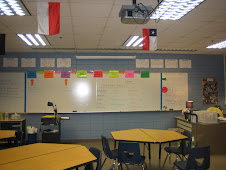Here are the questions for the seminar:
Stage 1 (Tell the Story)
Round Robin: Besides “unknown” what word sums up the citizen’s life and why?
What details are known about the citizen’s life?
Stage 2 (Themes)
What timeless themes does Auden develop?
What is Auden saying about individuals and society?
Stage 3 (Extend to Literature and Life)
Compare and contrast the characters and themes in this poem with the characters and themes in Brave New World.
How does the poem connect to life today?
In hour 6, I asked if people felt like "Unknown Students" in the school--students reduced to statistics for test scores, sports scores, etc. That opened up the discussion to a personal level, and the de Cafe got a little more lively then
If you still had thoughts on the poem or would like to comment further about the "Unknown Student" idea, feel free to do so as part of the comments of this post.
To re-read Auden's poem, click here.
Auden and Huxley lived very similar lives. To read about their entwined lives as pacifists who left Europe before World War II broke out, click on this Peace Magazine article.
I think both Huxley and Auden are putting down Henry Ford in their works, but I can't discover Ford's reaction to Brave New World or "Unknown Citizen."











